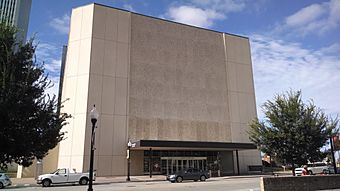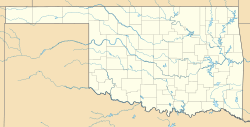Tulsa Performing Arts Center facts for kids

View of the Tulsa Performing Arts Center from the corner of 3rd Street and Cincinnati Avenue.
|
|
| Address | 110 E 2nd St. Tulsa, Oklahoma United States |
|---|---|
| Coordinates | 36°9′15″N 95°59′22″W / 36.15417°N 95.98944°W |
| Owner | City of Tulsa |
| Type | Performing arts center |
| Capacity | Chapman Music Hall: 2,365 John H. Williams Theatre: 437 Liddy Doenges Theatre: 300 Charles E. Norman Theatre: 200 |
| Construction | |
| Opened | March 19, 1977 |
| Architect | Minoru Yamasaki |
The Tulsa Performing Arts Center, also known as Tulsa PAC, is a special place in Tulsa, Oklahoma. It's where people go to watch live shows and performances. The center has four main theaters, a studio, an art gallery, and a big hall for events.
The largest theater, Chapman Music Hall, can hold 2,365 people. Many local groups perform here regularly. These include the Tulsa Ballet, Tulsa Opera, and Tulsa Symphony. Other groups like Theatre Tulsa and American Theatre Company also use the PAC.
Famous performers like Michael Bublé, Kelly Clarkson, and Steve Martin have appeared at the Tulsa PAC. The building opened in 1977. It was built using money from both the public and private donations. The center also has a collection of 76 art pieces.
Contents
History of the Tulsa PAC
The Tulsa Performing Arts Center opened on March 19, 1977. It was built with money from the city and from private donors. The famous architect Minoru Yamasaki designed the building. He also designed the original World Trade Center Towers.
The City of Tulsa owns and runs the PAC. A group called the TPAC Trust helps guide it. The Mayor of Tulsa is part of this trust. Robert D'Angelo was the first director. Mark Frie became the current director in June 2017.
Before the Tulsa PAC, the main theater was the Tulsa Municipal Theatre. This theater is now called the Brady Theater. In the early 1970s, people realized Tulsa needed a new, modern theater. A committee was formed to plan this new center.
They looked at fixing up older theaters. Then, John H. Williams, who led The Williams Companies, bought a large area of land. He planned to build a new office for his company. His original idea changed, and he gave some land to the City of Tulsa for a performing arts center.
In May 1973, John H. Williams and Leta Chapman, a generous community helper, made an offer. They said if Tulsa citizens voted to pay for half of the center, they would raise the other half. A campaign called "Everyone's Place" was launched. In August 1973, 69% of voters approved the plan. This meant $14 million was raised for the new Tulsa PAC.
Building the Center
Before construction began, a private company was created. This company managed the building project. This helped the construction move faster. A committee was also formed to buy art for the building.
Tulsa has a rule that 1% of public building costs must be spent on art. So, the PAC bought art from local, national, and international artists. This included many pieces of Native American art. Artists like Alexandre Hogue and Barbara Hepworth have art in the collection.
The first plan for the Tulsa PAC included one large hall and one smaller theater. During construction, two more studio theaters were added. Experts made sure the sound in the building was excellent. The total cost to build the Tulsa PAC was about $19 million. More money was found to cover the extra costs.
In the early 1990s, the PAC was updated. This made it easier for people with disabilities to use the building. In 2000, the PAC expanded again. They added another studio theater, a big reception hall, and more restrooms.
Performance Spaces
The Tulsa PAC has four main places for performances. These are Chapman Music Hall, John H. Williams Theatre, Liddy Doenges Theatre, and Charles E. Norman Theatre. There are also two smaller event spaces. These are the Kathleen P. Westby Pavilion and the Robert J. LaFortune Studio.
Chapman Music Hall
Chapman Music Hall is the biggest venue at the PAC. It can seat 2,365 people. Many famous artists have performed here. These include Tony Bennett, Luciano Pavarotti, and Norah Jones. Big Broadway musicals like The Lion King and The Phantom of the Opera have also been staged here. Ella Fitzgerald and the Tulsa Philharmonic performed at its opening on March 19, 1977.
John H. Williams Theatre
The John H. Williams Theatre is a smaller version of Chapman Music Hall. It can seat 437 people. It opened in March 1977. This theater hosts chamber music, piano concerts, and various plays. Poets and Celtic music groups have also performed here. Notable artists include U.S. Poet Laureate Billy Collins.
Liddy Doenges Theatre
This theater used to be called Studio I. It was renamed in 1994 after Liddy Doenges, who supported the arts. This "black box" theater has flexible seating for up to 300 people. It is often used for plays, special events, and cabaret shows.
Charles E. Norman Theatre
Charles E. Norman was a key leader in creating the Tulsa Performing Arts Center. He helped a lot during the planning and building stages. This theater used to be Studio II. It was renamed for him in 2000. This theater seats about 200 people. It is used for plays, receptions, and rehearsals.
Other Areas
Robert J. LaFortune Studio
This space was once used for small cabaret shows and press conferences. In 2023, it was updated into a lounge. It now has a stage, a bar, a dance floor, and seating. It can hold 200 people and can be rented for private parties. It is named after Mayor Robert J. LaFortune.
Kathleen P. Westby Pavilion
This large hall is almost 3,000 square feet. It can seat about 160 people at tables or 240 for lectures. It's great for gatherings before or after shows, and for parties. The PAC named this hall after Katie Westby in 2000. She was a longtime member of the PAC Trust. She also helped create the PAC's art collection. The public can rent this hall for events.
Achievements and Awards
The Tulsa Performing Arts Center has received many awards over the years.
- In 2015, Tulsa Voice readers voted it "Best Performing Arts Space."
- It was also named an "A-List Winner" by Tulsa People in 2015.
- Tulsa World readers called it the "Best Performing Arts Venue."
- Trip Advisor gave it a "Certificate of Excellence" in 2015.
The Tulsa Performing Arts Center was one of the first 15 performing arts centers in the United States to have its own website.
The ticket office at the Tulsa Performing Arts Center won the "Outstanding Box Office" award in 2013. This award came from the International Ticketing Association (INTIX).
The PAC's INTERMISSION Magazine won "PR Magazine of the Year" in 2011 and 2013. This was part of the Great Plains Journalism competition.
INTERMISSION also won First Place for Best Public Relations Magazine in 2006-07. This award was given by the Society of Professional Journalists.
Tulsa People Magazine voted the Tulsa Performing Arts Center "Best Venue to Hear Music" in 1994.
Oklahoma Magazine voted the Tulsa PAC "Place to See and Be Seen" in 2008.


